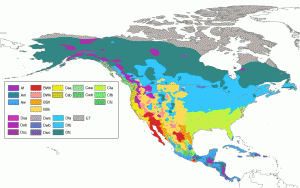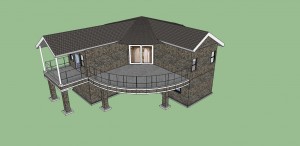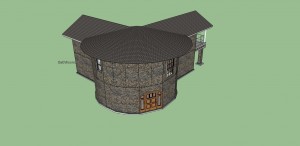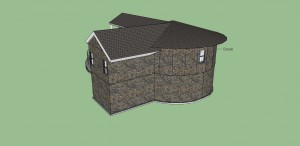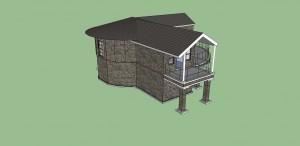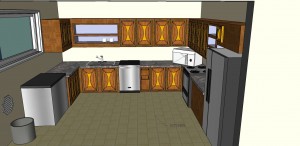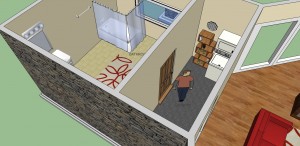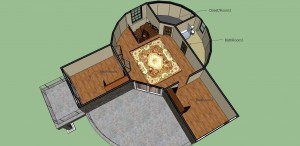Strategies for Climate Priorities:
Winter
-
Keep the heat in and the cold temperatures out during the summer
- Avoid building on cold northern slopes
- Build on the middle of slopes to avoid both the pools of cold air at the bottom and the high winds at the top of hills
- Use a compact design with a minimum surface-area-to-volume ratio (for example use two story buildings instead of one)
- Build attached or clustered buildings to minimize the number of exposed walls
- Use earth sheltering in the form of underground or bermed structures
- Place buffer spaces that have lower temperature requirements (closets, storage rooms, stairs, garages, gymnasiums, heavy work areas, etc.) along the north wall. Place a sun space buffer room on the south
- Use temperature zoning by both space and time since some spaces can be kept cooler than others at all times or at certain times. (Bedrooms can be kept cooler during the day, and living rooms can be kept cooler at night when everyone is asleep.)
- Minimize the window area on all orientations except south
- Use double or triple glazing, low-e coatings, and movable insulations on windows
- Use plentiful insulation in walls, on roofs, under floors, over crawl spaces, on foundation walls, and around slab edges
- Insulation should be a continuous envelope to prevent heat bridges. Avoid structural elements that are exposed on the exterior since they pierce the insulation. Avoid fireplaces and other masonry elements that penetrate the insulation layer
- Place doors on fireplaces to prevent heated room air from escaping through the chimney. Supply fireplaces and stoves with outdoor combustion air
-
Protect from the cold winter winds
- Avoid windy locations like hilltops
- Use evergreen vegetation to create windbreaks
- Use garden walls to protect the building and especially the entrances from cold winds
- In very windy areas, keep buildings close to the ground
- Use compact designs to minimize the surface area exposed to the wind
- Use streamlined shapes with rounded corners to both deflect the wind and minimize the surface-area-to volume ration
- Cluster buildings for mutual wind protection
- Use long sloping roofs , as in the New England saltbox houses, to deflect the wind over the building to create sheltered zones on the sunny side
- Place garages and other utility spaces on the winter windward side. Tis is usually the north, northwest, and northeast side of the building
- Use sun spaces and glazed-in porches as windbreaks
- Use earth sheltering or build in hallows. Also, the wind can be deflected by earth berms built against the wall or by constructing protective earth banks a short distance from the building
- Minimize openings, especially on the side facing the winter winds, and place the main entry on the leeward side
- Use storm windows, storm doors, air locks (vestibules), and revolving doors to minimize infiltration
- Close all attic and crawl space vents
- Use tight construction, caulking, and weather stripping to minimize infiltration. Use high-quality operable windows and doors
- Place outdoor courtyards on the south side of the building
- In winter, even windows in freestanding garden walls should be closed to protect the enclosure from the cold winds
- In snow country, use snow fences and windscreens to keep snow form blocking entries an south facing windows
-
Let the winter sun in
- Build on south, southeast, or southwest slopes.
- Check for solar access that might be blocked by landforms, vegetation, and manmade structures
- Avoid trees on the south side of the building
- Use only deciduous trees on the southeast and southwest sides
- Also, use deciduous trees on the east and west sides if winter is very long
- The long axis of the building should run east-west
- Most windows should face south
- Use south-facing clerestories and dormers instead of skylights
- Place spaces that benefit the most from solar heating along the south wall. Spaces that benefit the least should be along the north wall (storage rooms, grarages)
- Use an open floor plan to enable sun and sun-warmed air to penetrate throughout the building
- Use direct-gain, trombe walls and sunspaces for effective passive solar heating
- Use thermal mass on the interior to absorb and store solar radiation
- Use light-colored patios pavements, or land surfaces to reflect additional sunlight through windows
- Use specular reflectors (polished aluminum) to reflect additional sunlight through windows
- Use active solar collectors for domestic hot water, swimming pool heating, space heating, and process heat for industry
- If there I little or no summer overheating, use dark colors on exterior walls (especially the south walls)
- Create sunny but wind protected outdoor spaces on the south side of the building
-
Protect from the summer sun
- Avoid building on the east and especially west slopes. North slopes are best if solar heating is not require in the winter while south slopes are best if solar heating is desirable in the winter
- Use plants for shading. Evergreen trees can be used on the east, west and north sides of a building. Deciduous plants are most appropriate for shading the southeast, the southwest, and the roof.
- Avoid light-colored ground covers around the building to minimize reflected light entering windows unless day-light is an important strategy. Living ground covers are best because they do not heat the air while they absorb solar radiation
- Have neighboring buildings shade each other. Tall buildings with narrow alleys between them work best
- Avoid reflections from adjacent structures that have while walls and/or reflective glazing
- Build attached houses or clusters to minimize the number of exposed walls
- Use free-standing or wing walls to shade the east, west, and north walls
- Use the form of the building to shade itself (cantilever floors, balconies, courtyards)
- Avoid east and especially west windows if at all possible. Minimize the size and number of any east and west windows that are necessary. Project windows on the east and west facades so that they face n a northerly or southerly directions
- Use only vertical glazing. Any horizontal or sloped lazing should be shaded on the outside during the summer. Only skylights on the steel northern roofs do not require exterior shading
- Use exterior shading devices on all windows except north windows in cool climates
- Shade not only windows but also east and especially west walls. In very hot climate also shade the south wall
- Use a double or second roof (ice house roof), with the pace between the roofs well ventilated, use a parasol roof
- Use shaded outdoor spaces, such as porches and carports to protect the south, east and especially west facades
- Use open rather than solid shading devices to prevent trapping hot air nxt to the windows
- Use vines on trellises or shading
- Use moveable shading devices that can retract to all full winter sun penetration and more daylight on cloudy summer days
- Use highly reflective building surface (white is best). The roof and west wall are the most critical
- Use exterior shading devices in addition to exterior shading devices
- Use selective glazing to reduce heat gain but still allow views and day lighting
- Place outdoor courtyards, which are intended for summer use, on the north side of the building. The east side is the next best choice
-
Use natural ventilation for summer cooling
- Night ventilation that is used to cool the building in preparation for the next day is called “night flush cooling” and is described under priority VII
- Natural ventilation that cools people by passing air over their skin is called “comfort ventilation”
- Site and orient the building to capture the prevailing winds
- Direct and channel winds toward the building by means of the landscaping and landforms
- Keep building far enough apart to allow full access to the desirable winds
- In mild climates here winters are not very cold and summer temperatures are not extremely high, use a non-compact shape for maximum cross-ventilation
- Elevate the main living space since wind velocity increases with the height above ground
- Use high ceilings, two story spaces, and open stairwells for vertical air movement and for the benefits of stratification
- Provide cross-ventilation by using large windows on both the windward and leeward sides of the building
- Use fin walls to direct air through the windows
- Use a combination of high and low openings to take advantage of the stack effect
- Use roof openings to vent both the attic and the whole building. Use openings, such as monitors, cupolas, dormers, roof turrets, ridge vents, gable vents, and soffit vents
- Use porches to create cool outdoor space s and to protect open windows from sun and rain
- Use a double or parasol roof with sufficient clearance to allow the wind to ventilate the hot air collecting between the two roofs
- Use high-quality operable windows with good seals to allow summer ventilation while preventing winter infiltration
- Use an open floor plan for maximum air flow. Minimize the use of partitions
- Keep transoms and doors open between rooms
- Use a solar chimney to move air vertically through a building on calm, sunny days
- Use operable windows or moveable panels in garden walls to maximize the summer ventilation of a site while allowing protection against the winter winds
-
Allow natural ventilation to both cool and remove excess moisture in the summer
- All strategies from priority V apply
- Elevate the main living floor above the high humidity found near the ground
- Use plants sparsely. Minimize low trees, shrubbery, and ground cores to enable air to circulate through the site to remove moisture. Use only trees that have a high canopy
- Avoid deep basement that cannot be ventilated
-
Use thermal mass to reduce da-to-night temperature swings in the summer
- This cooling strategy is also knwown as “night flush”because the thermal mass is usually cooled with night ventilation
- Use massive construction materials since they hae a high heat capacity. Use materias such as brick, concrete, stone, and adobe
- Pplace insulation on the outside of the thermal mass
- If massive materialas are also to be used on the outside, sandwich the insulation between the inside and outside walls
- Use earth or rock in direct contact with the uninsulated walls
- Keep daytime hot air out of the building by closing all openings
- Open the building at night to allow cool air to enter. Use the strategies of natural ventilation, listed above in priority V, to maximize the night cooling of the thermal mass
- Use water as a thermal mass because of its high heat capacity. Use containers that maximize heat transfer into and out of the water
- Use radiant or evaporative cooling for additional temperature drop in the thermal mass at night
- Use mechanical equipment at night when it is most efficient to create a heat sink. By cooling the building at night the cool theral mass can soak up heat the next day
- Use earth sheltering to maximize the benefits of mass
-
Keep hot temperatures out during the summer
- Use compact designs to minimize the surface-area-to volume ratio
- Build attached house to minimize the number of exposed walls
- Use vegetation and shade structures to maintain cool ambient air around the building and to prevent reflecting sunlight into the windows
- Use earth sheltering in the form of underground or bermed structure
- Use plenty of insulation in the building envelope
- Use few and small windows to keep heat out
- Use exterior window sheltering shutters in hot climates use double glazing and in very hot climates also use moveable insulation over windows during the day when a space is unoccupied
- Isolate sources of heat in a separate room, wing, or building
- Zone building so that certain spaces are cooled only while occupied
- Use light-colored roofs and wall to reflect the sun’s heat
-
Use evaporative cooling in the summer
- Locate pools or fountains in the building, in a courtyard, or in the path of incoming winds
- Use transpiration by plants to cool the air both indoors and outdoors
- Spray water on roof, walls, and patios to cool these surfaces
- Pass incoming air through a curtain of water or a wet fabric
- Use a roof pond or another “indirect evaporative cooling” system
- Use an “evaporative cooler” This simple and inexpensive mechanical device uses very little electrical energy
-
Avoid creating additional humidity during the summer
- Do not use evaporative cooling strategies In humid climates
- Use underground or drop rather than spray irrigation
- Avoid pools and fountains
- Keep the area around the building dry by providing the proper drainage of land channel runoff water from the roof and paved areas away from the site
- Use permeable paving materials to prevent puddles on the surface
- Minimize plant especially indoors, use plants that add little water to the air by transpiration. Such plants are usually native to dry climates. Use trees that have a high canopy
- Shade plants and pools of water both indoors and out because the heat of the sun greatly increase the rate of transpiration and evaporation
- Use exhaust fans in kitchens, bathrooms, laundry rooms, etc., to remove excess moisture
-
Open the building to the outdoors since temperatures are comfortable much of the year
- Create outdoor space with different orientations for use at different times of the year. For example, use outdoor spaces on the south side in the winter and on the north side in the summer
- Create outdoor living areas that are sheltered from the hot summer sun and cool winter winds
- Use noncompact building deigns for maximum contact with the outdoors. Use an articulated building with many extensions or wings to create outdoor living spaces
- Use large areas oof operable windows, doors, and even moveable walls to increase contact with the outdoors
- Create pavilion-like buildings that have few interior partitions and minimal exterior walls
Sources:
